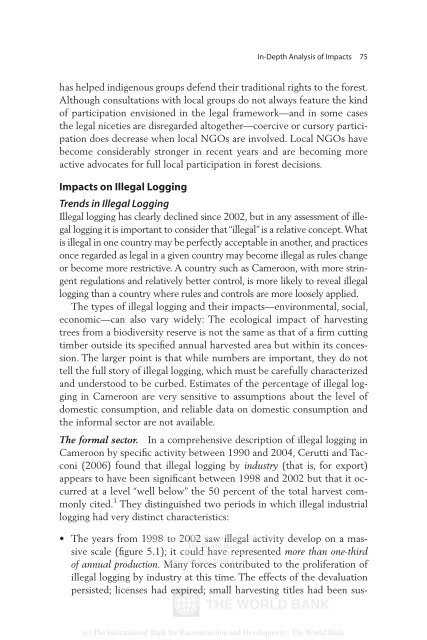The Rainforests of Cameroon - PROFOR
The Rainforests of Cameroon - PROFOR
The Rainforests of Cameroon - PROFOR
- No tags were found...
Create successful ePaper yourself
Turn your PDF publications into a flip-book with our unique Google optimized e-Paper software.
In-Depth Analysis <strong>of</strong> Impacts 75has helped indigenous groups defend their traditional rights to the forest.Although consultations with local groups do not always feature the kind<strong>of</strong> participation envisioned in the legal framework—and in some casesthe legal niceties are disregarded altogether—coercive or cursory participationdoes decrease when local NGOs are involved. Local NGOs havebecome considerably stronger in recent years and are becoming moreactive advocates for full local participation in forest decisions.Impacts on Illegal LoggingTrends in Illegal LoggingIllegal logging has clearly declined since 2002, but in any assessment <strong>of</strong> illegallogging it is important to consider that “illegal” is a relative concept. Whatis illegal in one country may be perfectly acceptable in another, and practicesonce regarded as legal in a given country may become illegal as rules changeor become more restrictive. A country such as <strong>Cameroon</strong>, with more stringentregulations and relatively better control, is more likely to reveal illegallogging than a country where rules and controls are more loosely applied.<strong>The</strong> types <strong>of</strong> illegal logging and their impacts—environmental, social,economic—can also vary widely: <strong>The</strong> ecological impact <strong>of</strong> harvestingtrees from a biodiversity reserve is not the same as that <strong>of</strong> a firm cuttingtimber outside its specified annual harvested area but within its concession.<strong>The</strong> larger point is that while numbers are important, they do nottell the full story <strong>of</strong> illegal logging, which must be carefully characterizedand understood to be curbed. Estimates <strong>of</strong> the percentage <strong>of</strong> illegal loggingin <strong>Cameroon</strong> are very sensitive to assumptions about the level <strong>of</strong>domestic consumption, and reliable data on domestic consumption andthe informal sector are not available.<strong>The</strong> formal sector. In a comprehensive description <strong>of</strong> illegal logging in<strong>Cameroon</strong> by specific activity between 1990 and 2004, Cerutti and Tacconi(2006) found that illegal logging by industry (that is, for export)appears to have been significant between 1998 and 2002 but that it occurredat a level “well below” the 50 percent <strong>of</strong> the total harvest commonlycited. 1 <strong>The</strong>y distinguished two periods in which illegal industriallogging had very distinct characteristics:• <strong>The</strong> years from 1998 Delivered to by 2002 <strong>The</strong> World saw illegal Bank e-library activity to: develop on a massivescale (figure 5.1); it could IP : 192.86.100.34 have represented more than one-third<strong>The</strong> World Bank<strong>of</strong> annual production. Many Mon, 09 forces Nov 2009 contributed 17:06:18 to the proliferation <strong>of</strong>illegal logging by industry at this time. <strong>The</strong> effects <strong>of</strong> the devaluationpersisted; licenses had expired; small harvesting titles had been sus-(c) <strong>The</strong> International Bank for Reconstruction and Development / <strong>The</strong> World Bank
















